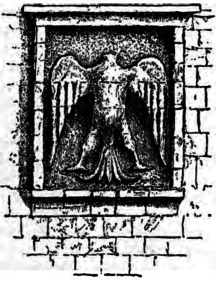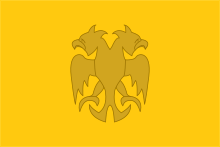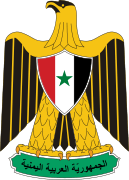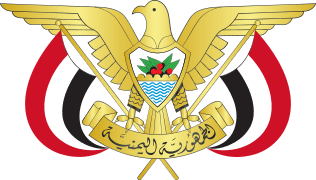Eagle of Saladin
The Eagle of Saladin (Arabic: عقاب صلاح الدين), in Egypt known as the Egyptian eagle (Arabic: العقاب المصري al-ʿuʾạb al-missry),[1] also known as the Republican Eagle (العقاب الجمهوري el-ʿuʾạb el-goumhūri), is a heraldic eagle used as an iconic symbol of Egypt. It is currently also used as part of coat of arms of Egypt, Iraq, and Palestine.

Origin of the eagle

The Ayyubid founder Saladin carried a yellow flag emblazoned with an eagle as his personal standard.[2] The Cairo Citadel, built during Saladin's rule over Egypt, has a large eagle on its west wall believed to depict Saladin's emblem. The eagle is currently headless, but was originally double-headed according to the Ottoman explorer Evliya Çelebi.[3] The course lines on the eagle do not correspond with those on the wall, suggesting that it was moved to its present location substantially after Saladin's rule, possibly during the rule of Muhammad Ali when the upper part of the wall was rebuilt.[3][4] The double-headed eagle symbol was also used on coins of Al-Adil I, a later Ayyubid sultan and brother of Saladin.[5]
Modern History
In modern history, the eagle with its current yellowish form was first introduced as a symbol of the Republic of Egypt during the 1952 Egyptian revolution. The emblem was then inherited as the U.A.R. coat of arms in 1958, and from this time the "Egyptian eagle" or the "Eagle of Saladin" was taken to represent wider nationalism and as a symbol of unity.
Following the 1963 Ramadan Revolution by the Iraqi Ba'ath Party, the Arab eagle was introduced as the new coat of arms of Iraq, directly based on the design used by Gamal Abdel Nasser for the Egyptian revolution.[6]
The Federation of Arab Republics established by Muammar Gaddafi in 1972 at first adopted a Hawk of Quraish as its emblem, but this was replaced by the Arab eagle in 1984.[7] Conversely, Gaddafi's Libyan Arab Republic in 1969 also adopted the eagle, but replaced it by the Hawk of Quraish in 1972.
In the Egyptian revolution of 2011, the eagle was associated with the Mubarak regime. Mehrez (2012) describes a stenciled graffiti depicting the Eagle of Saladin turned upside down as a call for the regime's downfall.
Ganzeer, an Egyptian graphics artist widely known for his revolutionary street art, explains, 'The current "Eagle of Saladin" emblem in the white band of the flag, however, wasn't used until 1984. Which means ... the current eagle on our flag belongs to Mubarak's regime.' This connection of the 'Eagle of Saladin' with the Mubarak regime provides the key to understanding this stencil piece.[8]
.svg.png) The first coat of arms of Republican Egypt (1953–58)
The first coat of arms of Republican Egypt (1953–58).svg.png) The current Egyptian coat of arms (1984–present)
The current Egyptian coat of arms (1984–present).svg.png) Iraqi coat of arms adopted after the Ramadan Revolution (1965–1991)
Iraqi coat of arms adopted after the Ramadan Revolution (1965–1991).svg.png) The current Iraqi coat of arms (2008–present)
The current Iraqi coat of arms (2008–present) Libyan Arab Republic coat of arms (1969–1972)
Libyan Arab Republic coat of arms (1969–1972).svg.png) The current Palestinian coat of arms
The current Palestinian coat of arms.svg.png) Coat of arms of the United Arab Republic (1958–1961)
Coat of arms of the United Arab Republic (1958–1961) Coat of arms of the Yemen Arab Republic (1962–1966)
Coat of arms of the Yemen Arab Republic (1962–1966) Coat of arms of the Yemen Arab Republic (1966–1974)
Coat of arms of the Yemen Arab Republic (1966–1974).svg.png) Coat of arms of the Yemen Arab Republic (1974–1990)
Coat of arms of the Yemen Arab Republic (1974–1990).svg.png) Coat of arms of the People's Democratic Republic of Yemen (1970–1990)
Coat of arms of the People's Democratic Republic of Yemen (1970–1990) Coat of arms of the Republic of Yemen (1990-present)
Coat of arms of the Republic of Yemen (1990-present)
See also
| Wikimedia Commons has media related to Eagle of Saladin. |
References
- Smith, Whitney (1975). Flags Through the Ages and Across the World. Maidenhead: McGraw-Hill. ISBN 0-07-059093-1.
- Hathaway, Jane (2003). A Tale of Two Factions: Myth, Memory, and Identity in Ottoman Egypt and Yemen. State University of New York Press. p. 96–7. ISBN 9780791458839.
- Rabbat, Nasser O. (1995). The Citadel of Cairo: A New Interpretation of Royal Mameluk Architecture. p. 24. ISBN 9789004101241.
- Smith, Whitney (1985). "New Flags". The Flag Bulletin. 24: 44., citing Meyer, L. A. (1933). Saracenic Heraldry. Oxford: Clarendon. p. 195.
- Ebers, Georg (1878). Egypt: Descriptive, Historical, and Picturesque, Volume I. New York: Cassell & Company LTD. p. 242.
- Baram, Amatzia (1991). Culture, History and Ideology in the Formation of Ba'thist Iraq,1968-89. Palgrave Macmillan UK. p. 151, note 15. ISBN 978-1-349-21243-9.
- Podeh, Elie (2011). The Politics of National Celebrations in the Arab Middle East. Cambridge University Press. pp. 87–. ISBN 978-1-107-00108-4.
- Mehrez, Samia (2012). Translating Egypt’s Revolution: The Language of Tahrir. American University of Cairo Press. pp. 119–. ISBN 978-1-61797-356-7.
External links
- The emblem of Egypt's flag, A.R.E. - The Golden Eagle of Egypt (Flags Of The World website)